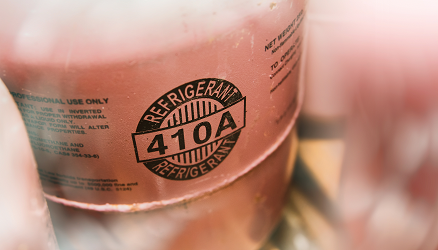Clean Air Act /Title V
 The Clean Air Act was first passed by Congress in 1970 and has since been amended several times. This legislation authorized the development of comprehensive Federal and State regulations to limit emissions from both stationary and mobile sources. The Georgia Tech campus and all of our fuel burning equipment counts as one such stationary source. Our convenient location right in the middle of Atlanta makes us subject to an even more strict set of rules, because our city and the surrounding area are classified as “non-attainment” with National Ambient Air Quality Standards for Ozone and Particulate Matter (fine). You can read more about Atlanta’s air quality here, and more about National Ambient Air Quality Standards (NAAQS) here.
The Clean Air Act was first passed by Congress in 1970 and has since been amended several times. This legislation authorized the development of comprehensive Federal and State regulations to limit emissions from both stationary and mobile sources. The Georgia Tech campus and all of our fuel burning equipment counts as one such stationary source. Our convenient location right in the middle of Atlanta makes us subject to an even more strict set of rules, because our city and the surrounding area are classified as “non-attainment” with National Ambient Air Quality Standards for Ozone and Particulate Matter (fine). You can read more about Atlanta’s air quality here, and more about National Ambient Air Quality Standards (NAAQS) here.
A large part of our campus utilizes distributed steam that we create right here at the Holland Plant. This steam is piped all over campus to keep our buildings warm and provide hot water for showers and dining halls. Other buildings on campus may have their own boilers or water heaters (along with other fuel burning equipment like emergency generators). We burn a lot of natural gas to run all of this equipment, and thanks to our aforementioned location in a non-attainment area, Georgia Tech is then classified as a “major source” of Nitrogen Oxides (NOx). As a good practice, our friends in the Facilities Design and Construction group and Auxiliary Services help by choosing to purchase low-NOx equipment when we build new buildings or perform renovations. As older, dirtier equipment gets phased out, the air we breathe gets cleaner!
Thanks to our status as a “major source,” we are subject to a Title V Operating Permit, issued by the Georgia Environmental Protection Division under the jurisdiction of the U.S. Environmental Protection Agency. There are pages upon pages of requirements within the permit, including reporting and record keeping requirements for processes and equipment located at all ends of the campus. One such permit condition requires that we submit a detailed report to the Environmental Protection Division summarizing our emissions once every six months. The permit doesn’t just cover fuel burning units. The scrubbers at the Marcus Nanotechnology building have several requirements in our permit, as does the fueling station at the motor pool.
As we build new buildings and place new fuel burning equipment and air pollution control devices on campus, we also must amend our permit to account for these additional emissions.
If you are considering adding any new fuel burning equipment, such as a boiler or an emergency generator, contact our office as soon as possible!
You can view our permit, along with all of our permit amendments, on the Georgia EPD’s website here.
Title VI - Protection of Stratospheric Ozone / Refrigerants
 Title VI of the Clean Air Act, “Protection of Stratospheric Ozone,” was put into place by the EPA to protect our planet’s vital ozone layer. Stratospheric ozone is a naturally-occurring gas that filters the sun's ultraviolet (UV) radiation. When the ozone layer is diminished, it allows more UV radiation to reach the Earth's surface. This can lead to increased diagnoses of skin cancer, cataracts, and weakened immune systems; it also leads to reduced crop yields, and disruptions to marine life. We are therefore required by this portion of the Clean Air Act to account for any emissions of ozone depleting substances. If you’d like to learn more, here’s a link to EPA’s Q&A about ozone.
Title VI of the Clean Air Act, “Protection of Stratospheric Ozone,” was put into place by the EPA to protect our planet’s vital ozone layer. Stratospheric ozone is a naturally-occurring gas that filters the sun's ultraviolet (UV) radiation. When the ozone layer is diminished, it allows more UV radiation to reach the Earth's surface. This can lead to increased diagnoses of skin cancer, cataracts, and weakened immune systems; it also leads to reduced crop yields, and disruptions to marine life. We are therefore required by this portion of the Clean Air Act to account for any emissions of ozone depleting substances. If you’d like to learn more, here’s a link to EPA’s Q&A about ozone.
Refrigerants come in hundreds of different blends, and we use a wide array of them here on campus. The most common types of refrigerants include CFCs (chlorofluorocarbons such as R11, R12, R113, R114, and R115), HCFCs (Hydrochlorofluorocarbons such as R22 and R123), and HFCs (Hydrofluorocarbons R134a, R404a, R407c, and R410a). Refrigerants are further characterized by two numbers, Ozone Depleting Potential (ODP), and Global Warming Potential (GWP). Both of these values are measured from 0 to 1. Because of their ozone depleting potential, the EPA has phased out CFCs entirely. We have very few pieces of equipment on campus that utilize CFCs. Most of our refrigerant containing equipment here on campus utilizes R134a, which is an HFC. HFCs do not deplete ozone (they have an ODP of zero). They may, however, have a Global Warming Potential greater than zero.
When someone on campus works on equipment that contains 50 pounds or more of any refrigerant, whether it be a contractor or in-house technician, we require that they submit a “Refrigerant Reporting Form”. Similarly, if a technician is removing a piece of refrigerant containing equipment, we require that they submit a “Refrigerant Removal Form". We do offer training for our folks on campus who work with refrigerant containing equipment as well.
If you have questions about refrigerants, please don’t hesitate to contact us.
